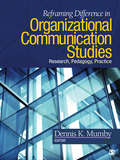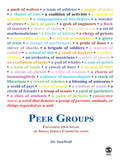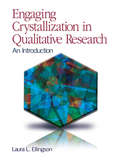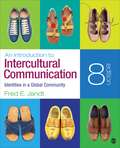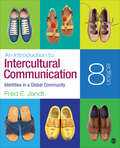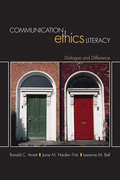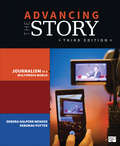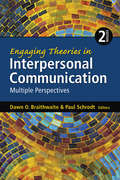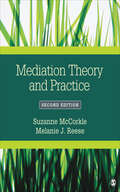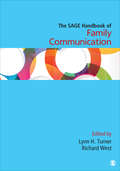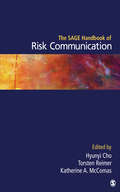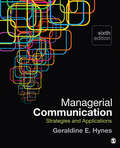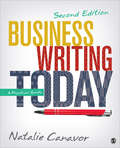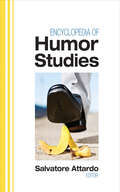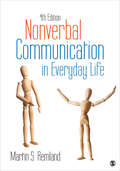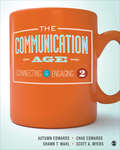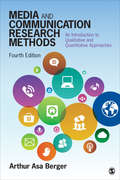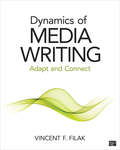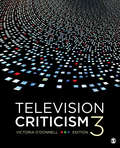- Table View
- List View
Reframing Difference in Organizational Communication Studies: Research, Pedagogy, and Practice
by Dennis K. MumbyBringing together prominent scholars in the field of organizational communication to examine the relationship between difference and organizing, this book explores the concept in a comprehensive and systematic way. Part I explores numerous ways in which difference can be critically examined as a communicative phenomenon; Part II addresses how best to teach difference, including pragmatic recommendations for explaining the topic and making it relevant to students' lives; and Part III broadly examines difference as a central construct in applied organizational communication research. Ultimately, the book serves to carve out a new agenda for studies of difference and organization, and it challenges instructors and students alike to think about and explore difference in a more complex and productive manner.
Peer Groups: Expanding Our Study of Small Group Communication
by SunWolfClans, cliques, clubs, or classmates: Students of group communication should be encouraged to think critically about concepts to the groups that matter to them most—peers. Peer Groups is the first textbook to explore group communication dynamics with this vital group. Drawing on a combination of traditional and new theories, Dr. SunWolf uses an inviting writing style, shares the words and provocative thinking of real world group members, and draws on research from social psychology, communication, and group dynamics. This innovative book offers suggestions for critical thinking and new behaviors in students' own peer groups and will inspire further exploration of small group dynamics.
Engaging Crystallization in Qualitative Research: An Introduction
by Laura L. EllingsonEngaging Crystallization in Qualitative Research, the first "how to" book to both explain and demonstrate crystallization methodology, offers a framework for blending grounded theory and other social scientific analyses with creative representations of data, such as narratives, poetry, and film. Author Laura L. Ellingson explores relevant epistemological questions that arise when crossing methodological boundaries, provides detailed steps for design and planning, offers guidelines for improving both social scientific and creative/artistic writing, and suggests strategies for targeting publication outlets for multigenre representations.
An Introduction to Intercultural Communication: Identities in a Global Community (Eighth Edition)
by Fred E. Edmund JandtAn Introduction to Intercultural Communication: Identities in a Global Community prepares today's students to successfully navigate our increasingly global community. Fred E. Jandt introduces essential communication skills and concepts that will empower readers to interact successfully with different cultures and ethnic groups. To spark student interest, Jandt offers readers unique insights into intercultural communication, at home and abroad, through an emphasis on history, culture, and popular media. Each chapter integrates material on social media, as well as extensive new examples from recent international news and events. Throughout the text, Jandt reinforces the important roles that stories, personal experiences, and self-reflection play in building our intercultural understanding and competence. The Eighth Edition adds depth to the coverage of theory and includes two new features: Focus on Skills provides expanded coverage of intercultural communication in practice, while Focus on Technology illustrates the impact of new communication technology on intercultural encounters. The new edition also introduces a new map program to provide students with additional context for discussion of cultures and regions across the globe.
An Introduction to Intercultural Communication: Identities in a Global Community
by Fred E. JandtAn Introduction to Intercultural Communication: Identities in a Global Community prepares today’s students to successfully navigate our increasingly global community. Fred E. Jandt introduces essential communication skills and concepts that will empower readers to interact successfully with different cultures and ethnic groups. To spark student interest, Jandt offers readers unique insights into intercultural communication, at home and abroad, through an emphasis on history, culture, and popular media. Each chapter integrates material on social media, as well as extensive new examples from recent international news and events. Throughout the text, Jandt reinforces the important roles that stories, personal experiences, and self-reflection play in building our intercultural understanding and competence. The Eighth Edition adds depth to the coverage of theory and includes two new features: Focus on Skills provides expanded coverage of intercultural communication in practice, while Focus on Technology illustrates the impact of new communication technology on intercultural encounters. The new edition also introduces a new map program to provide students with additional context for discussion of cultures and regions across the globe.
Communication Ethics Literacy: Dialogue and Difference
by Dr Ronald C. Arnett Dr Janie Fritz Dr Leeanne M. BellThis comprehensive and engaging treatment of communication ethics combines student application and theoretical engagement. Communication Ethics Literacy: Dialogue and Difference reviews classic communication ethics approaches and extends the conversation about dialogue and difference in public and private life. Introducing communication ethics as a pragmatic survival skill in a world of difference, the authors offer a learning model that frames communication ethics as arising from a set of goods found within particular narratives, traditions, or virtue structures that guide human life.
Advancing the Story: Journalism in a Multimedia World
by Debora R. Wenger Deborah PotterThis fully updated Third Edition of Advancing the Story, by Debora Halpern Wenger and Deborah Potter, builds on the essential strengths of the original text by providing clear instruction on reporting and producing for multiple platforms, real-world examples, advice from professional journalists and exercises to stimulate additional conversations. By focusing on the skills journalists need to leverage social media and capitalize on the use of mobile devices, the authors explore the role data-driven journalism is playing in the profession. Throughout the book, new screen shots, images, research and examples of broadcast and multimedia reporting bring concepts to life. Additionally, a greater emphasis on journalism ethics permeates the book, with each chapter now including a series of discussion starters to ensure that students consider the ethical implications of their journalistic decisions.
Advancing the Story: Journalism in a Multimedia World (Third Edition)
by Debora R. Wenger Deborah PotterThis fully updated Third Edition of Advancing the Story, by Debora Halpern Wenger and Deborah Potter, builds on the essential strengths of the original text by providing clear instruction on reporting and producing for multiple platforms, real-world examples, advice from professional journalists and exercises to stimulate additional conversations. By focusing on the skills journalists need to leverage social media and capitalize on the use of mobile devices, the authors explore the role data-driven journalism is playing in the profession. Throughout the book, new screen shots, images, research and examples of broadcast and multimedia reporting bring concepts to life. Additionally, a greater emphasis on journalism ethics permeates the book, with each chapter now including a series of discussion starters to ensure that students consider the ethical implications of their journalistic decisions.
Engaging Theories in Interpersonal Communication: Multiple Perspectives
by Dr Dawn O. Braithwaite Dr Paul SchrodtUse and Understand Interpersonal Communication Theories Engaging Theories in Interpersonal Communication: Multiple Perspectives highlights key theories used to guide interpersonal communication research. The Second Edition features 30 theory chapters written by leading scholars in interpersonal communication, including new coverage of evolutionary theories, Problematic Integration Theory, supportive communication theories, Theory of Motivated Information Management, critical approaches to interpersonal communication, and Media Multiplexity Theory. Each theory chapter follows the same structure to help readers easily find and compare information across theories. An updated introductory chapter maps the history and the current state of interpersonal communication theory since publication of the first edition, based on comprehensive analysis of published scholarship. Presenting both classic and cutting-edge issues, the book organizes theories into three clusters—theories that are individually-centered; theories that are focused on discourse and interaction processes; and theories that examine how communication functions in personal relationships. All authors interweave abstract theoretical concepts with concrete examples in order to maximize readability and comprehension.
Mediation Theory and Practice
by Suzanne McCorkle Melanie J. ReeseBlending theory and research with practical application, Mediation Theory and Practice, Second Edition, by Suzanne McCorkle and Melanie J. Reese, provides a thorough introduction to today’s ever expanding world of mediation, including updated research and new cases for analysis. Innovative yet practical, research-based yet readable, the book provides an overview of the basic principles of mediation in a variety of contexts to help readers understand mediation and its role in today’s society. Throughout the book, the authors help readers develop foundational mediation skills, including issue identification, setting the agenda for negotiation, problem solving, settlement, and closure. Case studies and examples in every chapter, plus an appendix of role-playing scenarios, make this book ideal book for both college courses and certification training programs.
The SAGE Handbook of Family Communication
by Dr Lynn H Turner Richard L. WestA thorough exploration of the critical topics and issues facing family communication researchers today The Sage Handbook of Family Communication provides a comprehensive examination of family communication theory and research. Chapters by leading scholars in family communication expand the definition of family, address recent shifts in culture, and cover important new topics, including families in crisis, families and governmental policies, social media, and extended families. The combination of groundbreaking theories, research methods, and reviews of foundational and emerging research in family communication make this an invaluable resource that explores the critical topics and issues facing family communication researchers today.
The SAGE Handbook of Risk Communication
by Hyunyi Cho Torsten Reimer Katherine A. McComasIn this comprehensive, state-of-the-art overview of risk communication, the field’s leading experts summarize theory, current research, and practice in a range of disciplines and describe effective communication approaches for risk situations in diverse contexts, such as health, environment, science, technology, and crisis. Offering practical insights, the contributors consider risk communication in all contexts and applications—interpersonal, organizational, and societal—offering a wider view of risk communication than other volumes. Importantly, the handbook emphasizes the communication side of risk communication, providing integrative knowledge about the models, audiences, messages, and the media and channels necessary for effective risk communication that enables informed judgments and actions regarding risk. Editors Hyunyi Cho, Torsten Reimer, and Katherine McComas have significantly contributed to the field of risk communication with this important reference work—a must-have for students, scholars, and risk and crisis communication professionals.
Managerial Communication: Strategies and Applications
by Geraldine E. HynesA Practical, Strategic Approach to Managerial Communication Managerial Communication: Strategies and Applications focuses on communication skills and strategies that managers need in today’s workplace. This book continues to be the market leader due to its strategic approach, solid research base, comprehensive coverage, balanced examination of oral and written communication, and focus on managerial, not entry-level, competencies. In the Sixth Edition, author Geraldine E. Hynes preserves the book’s key strengths while reflecting the realities of the contemporary workplace.
Business Writing Today: A Practical Guide
by Natalie C. CanavorConfident writers succeed. Whether you aim for a career in the business, nonprofit or government world, good writing equips you to stand out. In this accessible and reader-friendly book, Natalie Canavor shares a step-by-step framework to help you write strategically, win opportunities, and perform better on the job. You’ll know what to say and how to say it in any medium from email to blog, cover letter, proposal, resume, report, website, tweet, news release, and more. You’ll discover practical, grammar-free techniques to improve all your writing and learn how to recognize and fix your own problems with clear demonstrations. Business Writing Today, Second Edition, gives you tools, techniques and inside tips drawn from the worlds of journalism, corporate communications and public relations. It prepares you to better understand the business world and communicate in ways that achieve your own immediate and long range goals in today’s highly competitive work environment.
Encyclopedia of Humor Studies
by Salvatore I. AttardoThe Encyclopedia of Humor: A Social History explores the concept of humor in history and modern society in the United States and internationally. This work’s scope encompasses the humor of children, adults, and even nonhuman primates throughout the ages, from crude jokes and simple slapstick to sophisticated word play and ironic parody and satire. As an academic social history, it includes the perspectives of a wide range of disciplines, including sociology, child development, social psychology, life style history, communication, and entertainment media. Readers will develop an understanding of the importance of humor as it has developed globally throughout history and appreciate its effects on child and adult development, especially in the areas of health, creativity, social development, and imagination. This two-volume set is available in both print and electronic formats. Features & Benefits: The General Editor also serves as Editor-in-Chief of HUMOR: International Journal of Humor Research for The International Society for Humor Studies. The book’s 335 articles are organized in A-to-Z fashion in two volumes (approximately 1,000 pages). This work is enhanced by an introduction by the General Editor, a Foreword, a list of the articles and contributors, and a Reader’s Guide that groups related entries thematically. A Chronology of Humor, a Resource Guide, and a detailed Index are included. Each entry concludes with References/Further Readings and cross references to related entries. The Index, Reader’s Guide themes, and cross references between and among related entries combine to provide robust search-and-browse features in the electronic version. This two-volume, A-to-Z set provides a general, non-technical resource for students and researchers in such diverse fields as communication and media studies, sociology and anthropology, social and cognitive psychology, history, literature and linguistics, and popular culture and folklore.
Encyclopedia of Humor Studies
by Salvatore I. AttardoThe Encyclopedia of Humor: A Social History explores the concept of humor in history and modern society in the United States and internationally. This work’s scope encompasses the humor of children, adults, and even nonhuman primates throughout the ages, from crude jokes and simple slapstick to sophisticated word play and ironic parody and satire. As an academic social history, it includes the perspectives of a wide range of disciplines, including sociology, child development, social psychology, life style history, communication, and entertainment media. Readers will develop an understanding of the importance of humor as it has developed globally throughout history and appreciate its effects on child and adult development, especially in the areas of health, creativity, social development, and imagination. This two-volume set is available in both print and electronic formats. Features & Benefits: The General Editor also serves as Editor-in-Chief of HUMOR: International Journal of Humor Research for The International Society for Humor Studies. The book’s 335 articles are organized in A-to-Z fashion in two volumes (approximately 1,000 pages). This work is enhanced by an introduction by the General Editor, a Foreword, a list of the articles and contributors, and a Reader’s Guide that groups related entries thematically. A Chronology of Humor, a Resource Guide, and a detailed Index are included. Each entry concludes with References/Further Readings and cross references to related entries. The Index, Reader’s Guide themes, and cross references between and among related entries combine to provide robust search-and-browse features in the electronic version. This two-volume, A-to-Z set provides a general, non-technical resource for students and researchers in such diverse fields as communication and media studies, sociology and anthropology, social and cognitive psychology, history, literature and linguistics, and popular culture and folklore.
Nonverbal Communication in Everyday Life
by Martin S. RemlandNonverbal Communication in Everyday Life, Fourth Edition, is the most comprehensive, thoroughly researched, and up-to-date introduction to the subject of nonverbal communication available today. Renowned author Martin S. Remland introduces nonverbal communication in a concise and engaging format that connects foundational concepts, current theory, and new research findings to familiar everyday interactions. Presented in three parts, the text offers full and balanced coverage of the functions, channels, and applications of nonverbal communication. This approach not only gives students a strong foundation, but also allows them to fully appreciate the importance of nonverbal communication in their personal and professional lives.
Nonverbal Communication in Everyday Life
by Martin S. RemlandNonverbal Communication in Everyday Life, Fourth Edition, is the most comprehensive, thoroughly researched, and up-to-date introduction to the subject of nonverbal communication available today. Renowned author Martin S. Remland introduces nonverbal communication in a concise and engaging format that connects foundational concepts, current theory, and new research findings to familiar everyday interactions. Presented in three parts, the text offers full and balanced coverage of the functions, channels, and applications of nonverbal communication. This approach not only gives students a strong foundation, but also allows them to fully appreciate the importance of nonverbal communication in their personal and professional lives.
The Communication Age: Connecting and Engaging
by Dr Shawn T. Wahl Dr Chad C. Edwards Dr Autumn P. Edwards Dr Scott A. MyersWe are in "the communication age." No matter who you are or how you communicate, we are all members of a society who connect through the internet, not just to it. From face-to-face interactions to all forms of social media, The Communication Age, Second Edition invites you to join the conversation about today's issues and make your voice heard. This contemporary and engaging text introduces students to the essentials of interpersonal, small group, and public communication while incorporating technology, media, and speech communication to foster civic engagement for a better future.
Media and Communication Research Methods: An Introduction to Qualitative and Quantitative Approaches
by Dr Berger Arthur AMedia and Communication Research Methods, Fourth Edition is a concise and practical text designed to give students a step-by-step introduction to conducting media and communication research. Offering real-world insights along with the author’s signature animated style, this text makes the discussion of complex qualitative and quantitative methods easy to comprehend. Packed with detailed examples and practical exercises, the Fourth Edition of this bestselling introductory text includes a new chapter on discourse analysis; expanded discussion of social media, expanded coverage of the research process, and more. Ideal for undergraduate and graduate students conducting research for the first time, this accessible text will help students understand, practice, and master media and communication research.
Media and Communication Research Methods: An Introduction to Qualitative and Quantitative Approaches
by Dr Berger Arthur AMedia and Communication Research Methods, Fourth Edition is a concise and practical text designed to give students a step-by-step introduction to conducting media and communication research. Offering real-world insights along with the author’s signature animated style, this text makes the discussion of complex qualitative and quantitative methods easy to comprehend. Packed with detailed examples and practical exercises, the Fourth Edition of this bestselling introductory text includes a new chapter on discourse analysis; expanded discussion of social media, expanded coverage of the research process, and more. Ideal for undergraduate and graduate students conducting research for the first time, this accessible text will help students understand, practice, and master media and communication research.
Dynamics of Media Writing: Adapt and Connect
by Vincent F. FilakDynamics of Media Writing gives students transferable skills that can be applied across all media platforms—from traditional mass media formats like news, public relations, and advertising to emerging digital media platforms. Whether issuing a press release or tweeting about a new app, today’s media writers need to adapt their message for each specific media format in order to successfully connect with their audience. Throughout this text, award-winning teacher and college media adviser Vincent F. Filak introduces fundamental writing skills that apply to all media, while also highlighting which writing tools and techniques are most effective for specific media formats and why. User-friendly and loaded with practical examples and tips from professionals across mass media, this is the perfect guide for any student wanting to launch a professional media writing career.
Dynamics of Media Writing: Adapt and Connect
by Vincent F. FilakDynamics of Media Writing gives students transferable skills that can be applied across all media platforms—from traditional mass media formats like news, public relations, and advertising to emerging digital media platforms. Whether issuing a press release or tweeting about a new app, today’s media writers need to adapt their message for each specific media format in order to successfully connect with their audience. Throughout this text, award-winning teacher and college media adviser Vincent F. Filak introduces fundamental writing skills that apply to all media, while also highlighting which writing tools and techniques are most effective for specific media formats and why. User-friendly and loaded with practical examples and tips from professionals across mass media, this is the perfect guide for any student wanting to launch a professional media writing career.
Television Criticism
by Victoria J. O'DonnellTelevision Criticism, Third Edition by Victoria O'Donnell provides a foundational approach to the nature of television criticism. Rhetorical studies, cultural studies, representation, narrative theories, and postmodernism are introduced for greater understanding and appreciation of the critical perspectives on television with in-depth methods of criticism. Illustrated with contemporary examples, this updated Third Edition includes a new, extensive sample critical analysis of The Big Bang Theory and reflects recent changes in the ways television is viewed across multiple devices and the impact of the Internet on television.
Television Criticism
by Victoria J. O'DonnellTelevision Criticism, Third Edition by Victoria O'Donnell provides a foundational approach to the nature of television criticism. Rhetorical studies, cultural studies, representation, narrative theories, and postmodernism are introduced for greater understanding and appreciation of the critical perspectives on television with in-depth methods of criticism. Illustrated with contemporary examples, this updated Third Edition includes a new, extensive sample critical analysis of The Big Bang Theory and reflects recent changes in the ways television is viewed across multiple devices and the impact of the Internet on television.
